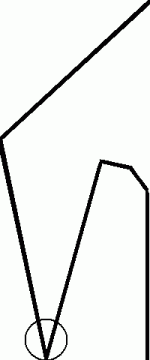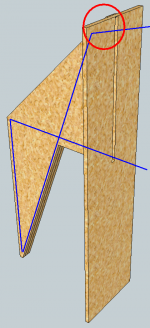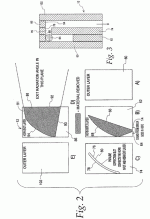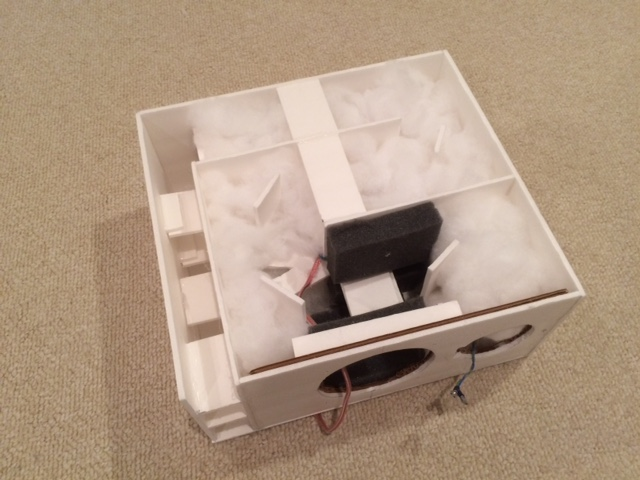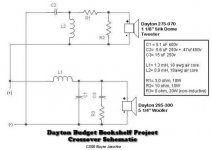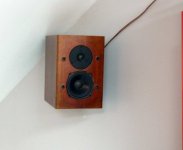Maybe I should make a 3d model and print a miniature 1/20 scale?
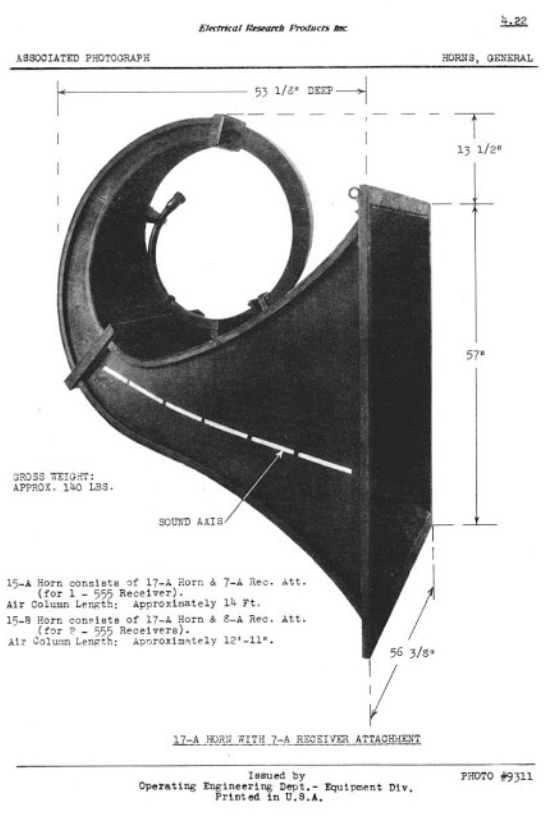
Just looking at the size of this thing, I can imagine that if it were loaded with a state of the art 2in full range like an SB65 or a P830983 or TB W2-852SH, it would be really really loud and sound quite nice.

Just looking at the size of this thing, I can imagine that if it were loaded with a state of the art 2in full range like an SB65 or a P830983 or TB W2-852SH, it would be really really loud and sound quite nice.
Last edited:
Hi guys,
I was just wondering, would it be possible to make a flattened version of the WE horn with... FC?
I've made couple of Paralines(kenpeter version) out of FC, but also a just a simple flat horn that is folded half in the middle just to keep it short(not really a calculated one - just eyeballed it...).
And it turned out better than I expected, so I'm thinking of making a bigger one...
What will happen if the WE horn's expansion grows on one plane only? Will it screw up the sound? (probably, but... hey, it's fun! )
)
Will this simple method of flattening the horn and just retaining the horizontal flare and folding it with slots no bigger than the width of the material used(derived from paraline patent) work with most horns?
What will the pros and cons be when using this method?
Would it have limited vertical vs wide horizontal dispersion like the paraline?
(or, in this case if the horn is laying flat horizontally, the opposite?)
Attached are pics of Kenpeter's sketches of flat folded horn from another thread, and one from the Paraline patent which shows folding a horn in the middle.(I can't get the last pic to turn! LOL)
I was just wondering, would it be possible to make a flattened version of the WE horn with... FC?
I've made couple of Paralines(kenpeter version) out of FC, but also a just a simple flat horn that is folded half in the middle just to keep it short(not really a calculated one - just eyeballed it...).
And it turned out better than I expected, so I'm thinking of making a bigger one...
What will happen if the WE horn's expansion grows on one plane only? Will it screw up the sound? (probably, but... hey, it's fun!
 )
)Will this simple method of flattening the horn and just retaining the horizontal flare and folding it with slots no bigger than the width of the material used(derived from paraline patent) work with most horns?
What will the pros and cons be when using this method?
Would it have limited vertical vs wide horizontal dispersion like the paraline?
(or, in this case if the horn is laying flat horizontally, the opposite?)
Attached are pics of Kenpeter's sketches of flat folded horn from another thread, and one from the Paraline patent which shows folding a horn in the middle.(I can't get the last pic to turn! LOL)
Attachments
It would work as a flat channel but you are losing about 1000% of the possible amplitude gain given the difference in the ratio of mouth CSA of the full 3d horn vs the flat land 2d horn. The dispersion perpendicular to the expansion would be like a line source omni paraline though.
My one experiment with paraline resulted in a very ragged response which confirmed the ragged response of the simulation in Akabak. So I think care has to be used to make everything smooth with no diffraction or reflection edges to the extent possible. Also, why limit your self to thickness of FC board? It's easy enough to make it say, 5in wide - in either case bracing pieces will be needed throughout to prevent the two panels from breathing mode vibrations.
You can curl it to keep it compact and you end up with something like a 1 channel Cornu.
My one experiment with paraline resulted in a very ragged response which confirmed the ragged response of the simulation in Akabak. So I think care has to be used to make everything smooth with no diffraction or reflection edges to the extent possible. Also, why limit your self to thickness of FC board? It's easy enough to make it say, 5in wide - in either case bracing pieces will be needed throughout to prevent the two panels from breathing mode vibrations.
You can curl it to keep it compact and you end up with something like a 1 channel Cornu.
Thanks for the explanation, xrk!
So I guess just making it flat and big isn't going to have much benefits.
As for the ragged response in the Paraline - what do you think if one were to make the Paraline for just utilizing it as a midrange horn? (Would the ragged response matter that much in a say, 250-1000 range?)
I've made a 19x35 inch paraline with FC few months ago, but couldn't get the sound right.
Later I found out that having the port holes too small(don't know the exact formulas for those either ) makes the sound somewhat 'shrill(?)'. And when I opened them up, I actually enjoyed the sound more.
) makes the sound somewhat 'shrill(?)'. And when I opened them up, I actually enjoyed the sound more.
On the other hand, when opened up too much, it becomes 'muddy' or 'laid back'. (when it comes to describing qualities of sound, it gets baffling, so please pardon my mistakes...)
Aren't the holes for the port supposed to be quite small? But every time I made them small, the midranges sounded 'harsh'...
I must be doing something wrong... (Unsuitable drivers and whatnot... )
)
Anyway, attached are pics of my second attempt at building Paralines.
(These are kenpeter's version...)
So I guess just making it flat and big isn't going to have much benefits.
As for the ragged response in the Paraline - what do you think if one were to make the Paraline for just utilizing it as a midrange horn? (Would the ragged response matter that much in a say, 250-1000 range?)
I've made a 19x35 inch paraline with FC few months ago, but couldn't get the sound right.
Later I found out that having the port holes too small(don't know the exact formulas for those either
On the other hand, when opened up too much, it becomes 'muddy' or 'laid back'. (when it comes to describing qualities of sound, it gets baffling, so please pardon my mistakes...)
Aren't the holes for the port supposed to be quite small? But every time I made them small, the midranges sounded 'harsh'...
I must be doing something wrong... (Unsuitable drivers and whatnot...
Anyway, attached are pics of my second attempt at building Paralines.
(These are kenpeter's version...)
Attachments
-
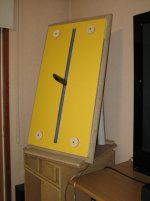 72_IMG_1568.jpg798.6 KB · Views: 120
72_IMG_1568.jpg798.6 KB · Views: 120 -
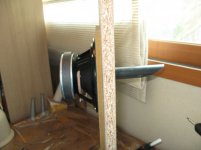 72_IMG_1562.jpg460.1 KB · Views: 97
72_IMG_1562.jpg460.1 KB · Views: 97 -
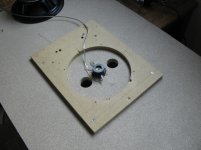 72_IMG_1558.jpg602.4 KB · Views: 74
72_IMG_1558.jpg602.4 KB · Views: 74 -
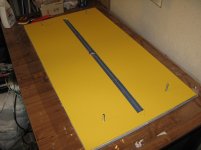 72_IMG_1554.jpg542.3 KB · Views: 71
72_IMG_1554.jpg542.3 KB · Views: 71 -
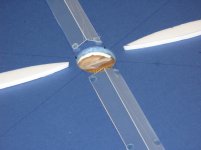 72_IMG_1552.jpg606.4 KB · Views: 80
72_IMG_1552.jpg606.4 KB · Views: 80 -
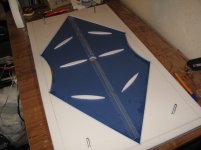 72_IMG_1551.jpg551.2 KB · Views: 80
72_IMG_1551.jpg551.2 KB · Views: 80 -
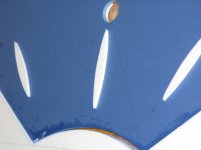 72_IMG_1550.jpg528.4 KB · Views: 67
72_IMG_1550.jpg528.4 KB · Views: 67 -
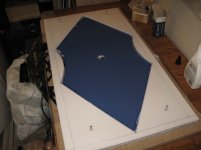 72_IMG_1547.jpg522.6 KB · Views: 73
72_IMG_1547.jpg522.6 KB · Views: 73 -
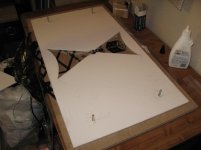 72_IMG_1545.jpg508.9 KB · Views: 74
72_IMG_1545.jpg508.9 KB · Views: 74 -
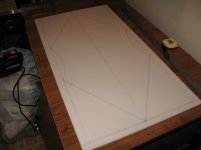 72_IMG_1539.jpg485.6 KB · Views: 365
72_IMG_1539.jpg485.6 KB · Views: 365
This is not a full range build, but as foam core speakers go, it's one of the best sounding speakers you can make for $40 worth of drivers and two sheets of foam core. The size is also very compact for how big the sound is. Volume and sound stage wise it sounds like a speaker with an 8in driver. The Dayton Classic series drivers are a great value and actually are capable of monitor like performance. DC130A-8 for woofer and DC28F-8 silk dome tweeter.
You know a speaker sounds good when I take the time to build a stereo pair.
The use of a front firing TL really augmented the volume of the bass output. In 4 PI space I am measuring 84dB sensitivity at 2.83v. 47Hz f3 and in absence of room reflections are +/-2dB over operating range which tops out at 22kHz. The design uses a Harsch cross over topology for quasi transient perfect response. XO frequency is 1300Hz acoustical (2kHz BW1 HPF on tweeter and BW4 LPF on woofer - electrical).
http://www.diyaudio.com/forums/mult...ed-tl-monitor-dc130a-dc28f-8.html#post4536413
Here is final assembly of second unit.
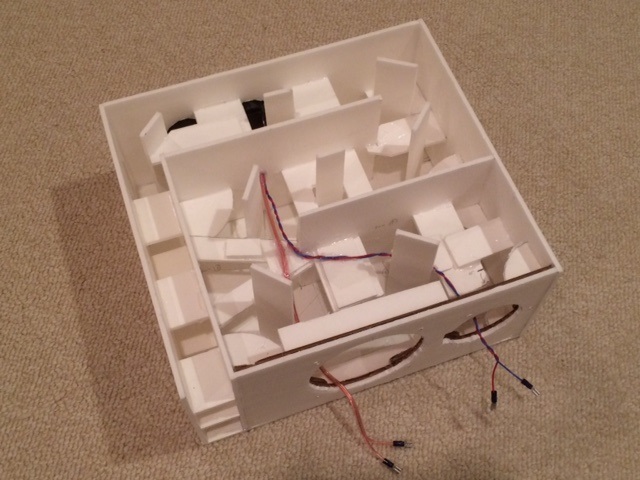
Here is the pair (note flush mounted drivers to minimize diffraction - critical step):
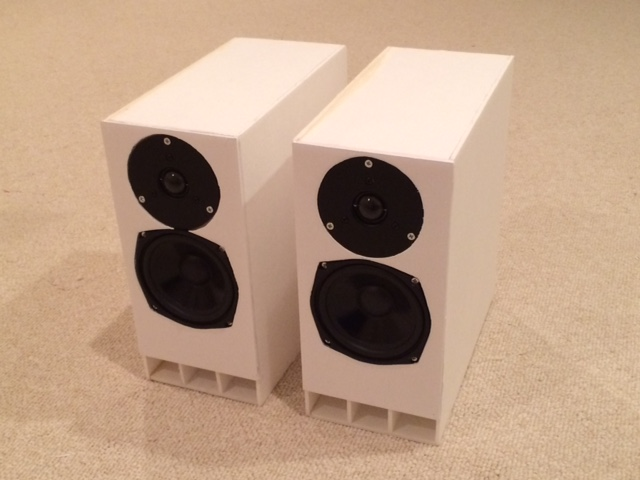
Frequency response of both units:
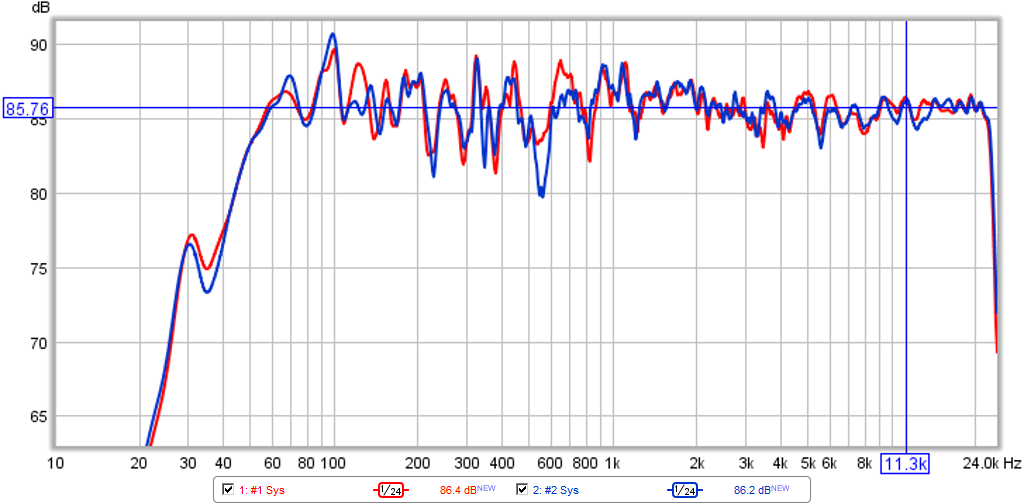
Distortion at typical listening levels is quite low - substantial bass capability that is well beyond what one expects from a bookshelf speaker with 5.25in woofer - the best I have measured for this size speaker:
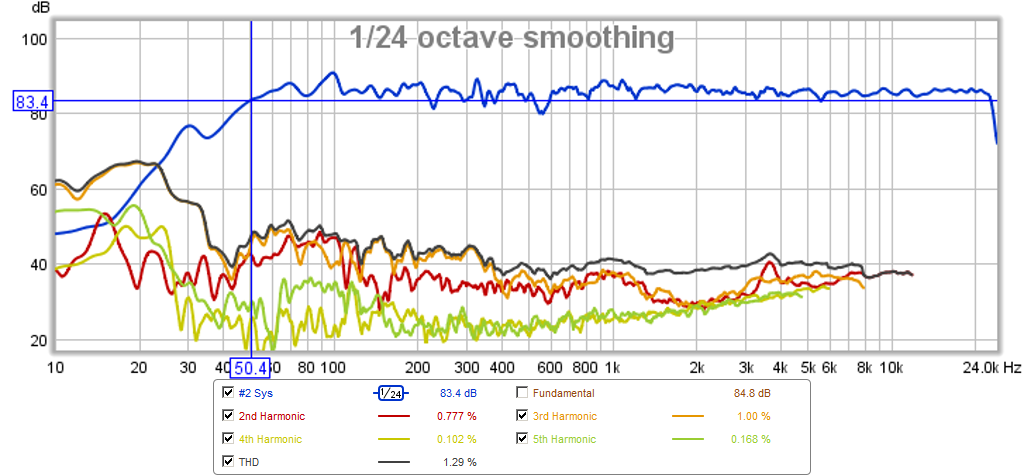
Highly recommended build if you want a compact, accurate speaker with room filling sound.
The best part - group delay is very low at 6.5ms at 50Hz, 2.7ms at 100Hz - similar to a sealed alignment but with way more extension.
You know a speaker sounds good when I take the time to build a stereo pair.
The use of a front firing TL really augmented the volume of the bass output. In 4 PI space I am measuring 84dB sensitivity at 2.83v. 47Hz f3 and in absence of room reflections are +/-2dB over operating range which tops out at 22kHz. The design uses a Harsch cross over topology for quasi transient perfect response. XO frequency is 1300Hz acoustical (2kHz BW1 HPF on tweeter and BW4 LPF on woofer - electrical).
http://www.diyaudio.com/forums/mult...ed-tl-monitor-dc130a-dc28f-8.html#post4536413
Here is final assembly of second unit.

Here is the pair (note flush mounted drivers to minimize diffraction - critical step):

Frequency response of both units:

Distortion at typical listening levels is quite low - substantial bass capability that is well beyond what one expects from a bookshelf speaker with 5.25in woofer - the best I have measured for this size speaker:

Highly recommended build if you want a compact, accurate speaker with room filling sound.
The best part - group delay is very low at 6.5ms at 50Hz, 2.7ms at 100Hz - similar to a sealed alignment but with way more extension.
Last edited:
PJN,
Thanks for the info and the XO tip! Much simpler than the passive XO I designed which is a Harsch quasi transient perfect:
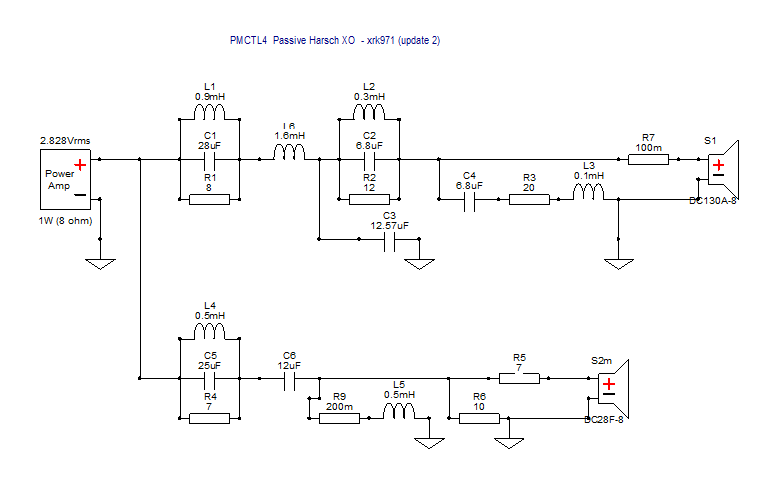
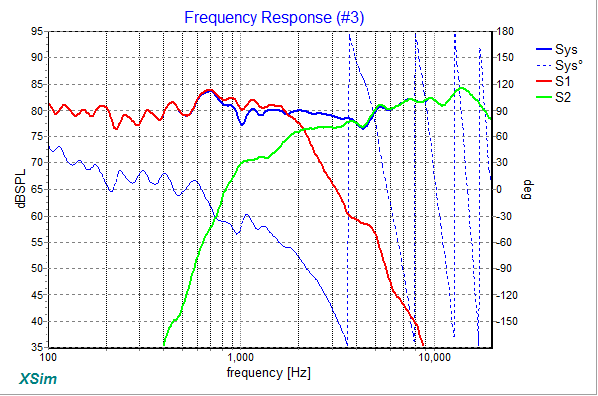
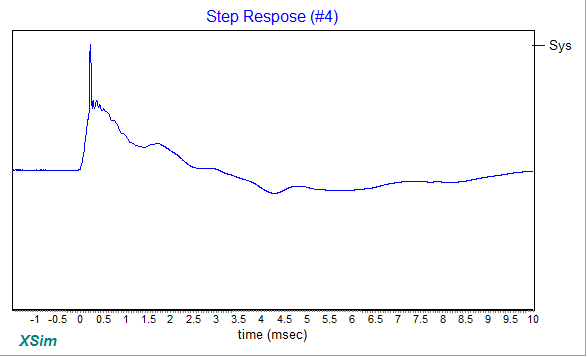
I will have to put the XO you linked into Xsim and see what I get.
I agree that they are fantastic sounding speakers for the money. You don't need expensive drivers for a speaker to sound exceptionally good.
Do you have any measurements from your build?
Thanks for the info and the XO tip! Much simpler than the passive XO I designed which is a Harsch quasi transient perfect:



I will have to put the XO you linked into Xsim and see what I get.
I agree that they are fantastic sounding speakers for the money. You don't need expensive drivers for a speaker to sound exceptionally good.
Do you have any measurements from your build?
Hi X,
Unfortunately I don' have any with me, but I took them to a speaker gathering about 10 years or so ago at Dennis Murphy's house near DC soon after I built them. He measured them doing a frequency sweep, and as I recall they were nice and linear. They were a big hit at the show, I remember that when they were being auditioned one guy asked for the subwoofer to be turned off so he could hear what they sounded like, there was no subwoofer on. The enclosures are ~ 1/2 Ft2 tuned to ~ 50 Hz if I recall, the details are still in the article on PE. Made out of MDF, the only mods that I made were to dampen the frames with silicone. I still enjoy them today when I'm doing projects in my garage. Here is a pic of them in their place of honor.
Paul
Unfortunately I don' have any with me, but I took them to a speaker gathering about 10 years or so ago at Dennis Murphy's house near DC soon after I built them. He measured them doing a frequency sweep, and as I recall they were nice and linear. They were a big hit at the show, I remember that when they were being auditioned one guy asked for the subwoofer to be turned off so he could hear what they sounded like, there was no subwoofer on. The enclosures are ~ 1/2 Ft2 tuned to ~ 50 Hz if I recall, the details are still in the article on PE. Made out of MDF, the only mods that I made were to dampen the frames with silicone. I still enjoy them today when I'm doing projects in my garage. Here is a pic of them in their place of honor.
Paul
Attachments
I have an update on extended listening impressions with these TL speakers. I moved them to my desk as PC monitors. I remeasured the response at my listening position and made some minor tweaks to the EQ to reduce effect of desk reflection anomalies. The rear wall and desk really boosted the bass which is now flat to 30Hz with distortion still below 3% at those low frequencies at typical 85dB listening levels.
The bass is really quite remarkable in depth and body - without being boomy or flappy sounding. The mids are very clear and smooth and I love the highs from the DC28F - a superb sounding tweeter period. I tested all genres and as expected, a flat response monitor sounds good with all music. What struck me is the bass extension though - it sounds like there is a sub woofer supporting it. Cannot believe it is from a pair of 5.25in lowly Dayton Classics. Very impressive sounding speaker that is really quite capable of going against something like a Genelec with an 8in woofer. The Genelec may get louder ultimate SPL but this sounds better with lower distortion in bass at moderate SPL's.
The bass is really quite remarkable in depth and body - without being boomy or flappy sounding. The mids are very clear and smooth and I love the highs from the DC28F - a superb sounding tweeter period. I tested all genres and as expected, a flat response monitor sounds good with all music. What struck me is the bass extension though - it sounds like there is a sub woofer supporting it. Cannot believe it is from a pair of 5.25in lowly Dayton Classics. Very impressive sounding speaker that is really quite capable of going against something like a Genelec with an 8in woofer. The Genelec may get louder ultimate SPL but this sounds better with lower distortion in bass at moderate SPL's.
- Home
- Loudspeakers
- Full Range
- Foam Core Board Speaker Enclosures?
